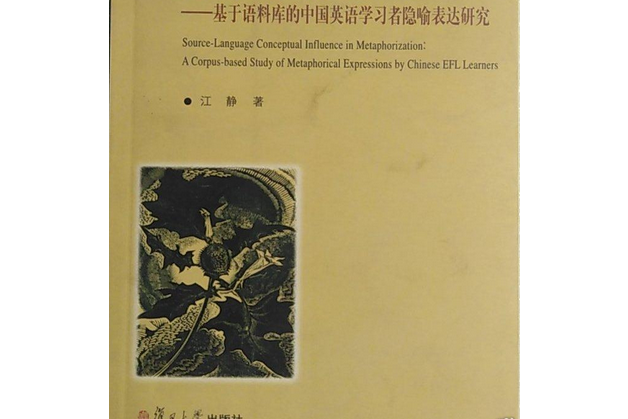《隱喻化中的源語概念影響:基於語料庫的中國英語學習者隱喻表達研究》是2011年復旦大學出版社出版的圖書,作者是江靜。
基本介紹
- 書名:隱喻化中的源語概念影響:基於語料庫的中國英語學習者隱喻表達研究
- 作者:江靜
- 出版社:復旦大學出版社
- 出版時間:2011年4月
- 頁數:317 頁
- 定價:25 元
- 開本:32 開
- 裝幀:平裝
- ISBN:9787309079296
內容簡介,圖書目錄,
內容簡介
本書旨在把認知語言學中的概念隱喻理論與套用語言學中的二語習得結合起來,從隱喻化角度探索隱喻語言學習中的源語概念遷移現象。作者提出,隱喻化是一種多層動態的概念機制,從而建立了隱喻義形成的潛在認知模型。在此基礎上,本書對英漢隱喻化進行巨觀對比分析和微觀對比分析,揭示英漢隱喻化的異同。在對英語本民族語學生語料庫和中國學習者語料庫進行對比分析後,作者發現英漢隱喻化的異同會導致中國英語學習者隱喻義習得過程中受到源語的概念影響。該研究為語言遷移現象提供了新的思路,強調在二語習得中應該增強源語概念影響意識。
本書對廣大高校英語教師以及從事語言學和套用語言學研究的人員具有較高的參考價值。
圖書目錄
Contents
List of Figures
List of Tables
List of Abbreviations
Acknowledgements
前言
Chapter One Introduction
1.1 Research Background
1.2 Purpose of the Book
1.3 Significance of the Study
1.4 Organization of the Book
Chapter Two Metaphorization Across Languages
2.1 The Modern View:Conceptual Metaphor Theory
2.1.1 Nature of Conceptual Metaphor
2.1.2 Conceptual Metaphor System
2.1.3 The Philosophical Background:Experientialism
2.1.4 Three Types of Conceptual Metaphors
2.2 Image Schema Underlying Conceptual Metaphor
2.2.1 Definition and Properties of Image Schema
2.2.2 Diagram or Image:Representation of Image Schema
2.2.3 The Invariance Principle:Image Schema in Metaphor
2.3 Metaphorization
2.3.1 Definition of Metaphorization
2.3.2 Conceptualization and Language
2.3.3 Metaphorization and Metaphorical Language
2.3.4 Three Mechanisms of Metaphorization
2.4 Cross-linguistic Metaphorization
2.4.1 Universalism and Relativism of Human Conceptualization
2.4.2 Necessity of Cross-linguistic Metaphorization Study
2.4.3 M etaphor Studies in China and Importance of PresentResearch
Chapter Three SL Conceptual Influence in Metaphorization
3.1 Definition of Language Transfer
3.2 A Historical Overview of Language Transfer Studies
3.2.1 The Behaviorist Approach
3.2.2 The Mentalist Approach
3.2.3 The Current Trend:the Cognitive Approach
3.3 A New Term:SL Conceptual Influence
3.3.1 Need for a New Framework
3.3.2 Terminology of SL Conceptual Influence
3.3.3 Linguistic Manifestations of SL Conceptual Influence
3.4 Theoretical Support for SL Conceptual Influence
3.4.1 Psychological Basis
3.4.2 Thinking for Speaking Theory
3.4.3 Compound Conceptual System Theory
3.4.4 Conceptual Fluency Theory
3.5 SCI in Metaphorization atLexicosemantic Level
3.5.1 SCI at Lexicosemantic Level
3.5.2 SCI in Metaphorization on Learning TL Metaphorical Senses
3.5.3 Reality of SCI in Metaphorization Lexicosemantic Level
3.6 A Cognitive Model in Lexicosemantic Analysis
3.6.1 The Theoretical Framework of Cognitive Semantics
3.6.2 Three Conceptual Mechanism s in Meaning Formation
3.6.2.1 Image schemata in lexical semantic analysis
3.6.2.2 Metaphoricalmappings in lexical semantic analysis
3.6.2.3 Prototypicality in lexical semantic analysis
3.6.3 Summary:A HierarchicalModel
Chapter Four Research Design
4.1 Methodology I:An E-C Comparative Study of Metaphorization
4.1.1 A Macro-perspective Contrastive Analysis
4.1.1.1 Data collection
4.1.1.2 Data analysis
4.1.2 A Micro-perspective Contrastive Analysis
4.1.2.1 Justification of the case study of RED,UP and OUT
4.1.2.2 RED,UP and OUT vs.red,up and out
4.1.2.3 Data collection:the dictionary-based and corpus-based approach
4.1.2.4 Data analysis:categorization and statistics
4.2 Methodology II:An Empirical Study of SCI of Metaphorization
4.2.1 Contrastive Interlanguage Analysis
4.2.1.1 Rationale ofContrastive Interlanguage Analysis
4.2.1.2 Data collection:native-student corpus and learner corpus
4.2.1.3 Data analysis:three steps
4.2.2 Error Analysis
4.2.2.1 Rationale of error analysis
4.2.2.2 Data collection:sample collection and identification of errors
4.2.2.3 Data analysis:description and explanation of errors
Chapter Five An E-C Comparative Study of Metaphorization
5.1 The Macro-perspective Contrastive Analysis
5.1.1 Structural Metaphorization
5.1.2 Orientational Metaphorization
5.1.3 Ontological Metaphorization
5.2 The Micro-perspective Contrastive Analysis
5.2.1 The RED Metaphorization
5.2.1.1 The metaphorical senses of“red”in English and“hong”in Chinese
5.2.1.2 The RED schemata and their prototypicality in English and Chinese
5.2.1.3 The RED mappings and their prototypicality in English and Chinese
5.2.2 The UPM etaphorization
5.2.2.1 The metaphorical senses of“up”in English and“shang”&“qi”in Chinese
5.2.2.2 The UP schemata and their prototypicality in English and Chinese
5.2.2.3 The UP mappings and their prototypicality in English and Chinese
5.2.3 The OUT Metaphorization
5.2.3.1 The metaphorical senses of“out”in English and“chu”&“wai”in Chinese
5.2.3.2 The OUT schemata and their prototypicality in English and Chinese
5.2.3.3 The OUT mappings and their prototypicality in English and Chinese
5.3 Summary
Chapter Six An Empirical Study of SC I in Metaphorization
6.1 A Corpus-based Contrastive Interlanguage Analysis
6.1.1 MetaphoricalUses in the Corpora
6.1.2 SCI in Metaphorization of the Concept RED
6.1.2.1 The influence of E-C congruence in RED schemata and mappings
6.1.2.2 The influence of E-C prototypicality in RED schemata and mappings
6.1.3 SCI in Metaphorization of the Concept UP
6.1.3.1 The influence of E-C congruence UP schemata and mappings
6.1.3.2 The influence of E-C prototypicality in UP schemata and mappings
6.1.4 SCI in Metaphorization of the Concept OUT
6.1.4.1 The influence of E-C congruence in OUT schemata and mappings
6.1.4.2 The influence of E-C prototypicality in OUT schemata and mappings
6.1.5 A General Discussion
6.2 ErrorAnalysis
6.2.1 Description of Errors
6.2.2 Classification of Errors
6.2.3 Explanation of Errors
6.2.4 SCI and L1-induced Errors
6.2.4.1 The influence of Chinese mappings and prototypicality on RED errors
6.2.4.2 The influence of Chinese mappings and prototypicality on UP errors
6.2.4.3 The influence of Chinese mappings and prototypicality on OUT errors
6.2.5 A General Discussion
Chapter Seven Conclusions and Implications
7.1 Conclusions
7.1.1 Research Question1
7.1.2 Research Question2
7.2 Implications
7.2.1 Theoretical Implications
7.2.2 Pedagogical Implications
7.3 Limitations
References
Appendices
Appendix1 Raw data in macro-perspective contrastive analysis
Appendix2 Raw data in m icro-perspective contrastive analysis
Appendix3 Topics for writings in NSC and LCs
Appendix4 Raw data in contrastive interlanguage analysis
Appendix5 Independent-samples Ttest results in contrastive interlanguage analysis
Appendix6 Interview
Appendix7 Raw data in error analysis

